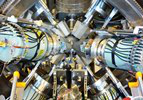Speaker
Dr
Magdalena Kowalska
(CERN PH Department)
Description
-ray transitions in muonic atoms have been used to derive absolute charge radii of many stable nuclei. Presently, the obtained radii, together with those provided by electron scattering, are used extensively as input to connect the optical isotope shifts with changes in charge radii for radioactive nuclei. Laser spectroscopy on radioactive nuclei which provides these optical isotope shifts is at present a very active field (3 setups at CERN-ISOLDE alone) and thus many radii of stable nuclei are used every year as calibrations. And because changes in charge radii are very small, it is important that the reference radii of stable isotopes, or at least their differences, are very precise and free of large systematic errors. Unfortunately, radii derived so far from muonic atom transitions – measured mostly in 1970’ and 1980’s – have large systematic uncertainties. This is partly due to quite uncertain nuclear polarization corrections, which were calculated with methods available at that point. And these uncertainties propagate to differences in radii of unstable nuclei.
In addition, the calibration of optical isotope shifts requires at least 3 isotopes with already known charge radii, so for chemical elements with fewer stable or extremely long-lived isotopes the connection between optical isotope shifts and changes in charge radii has to rely on atomic theory which in most cases has still too large uncertainties.
For the above reasons, in order to derive precise radii of radioactive nuclei, it would be extremely interesting to investigate again muonic transitions in some of the stable nuclei as well as in long-lived isotopes for elements where only 2 radii have been measured before. In addition, if the studies can be extended to more unstable isotopes, this would allow studying charge radii of unstable nuclei with a new method and could even provide results for nuclei which are difficult to access with laser spectroscopy.
These new measurements have to be accompanied with new calculations of nuclear (and other) corrections, using modern approaches and the available computing power.
This presentation will show briefly how charge radii were derived from Muonic-atom data in the past, how they are used to calibrate optical isotope shifts and why the uncertainties are too large, and finally how the situation can be improved with new muonic-atom measurements and calculations.
Author
Dr
Magdalena Kowalska
(CERN PH Department)

